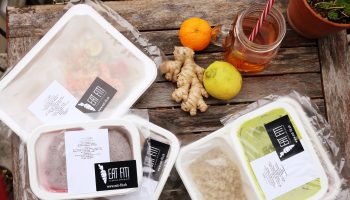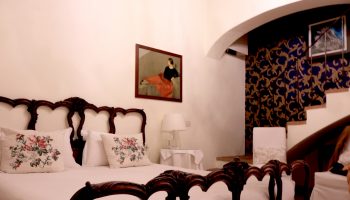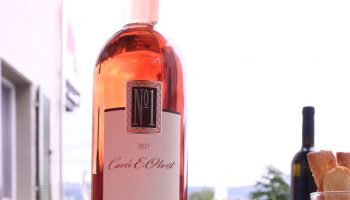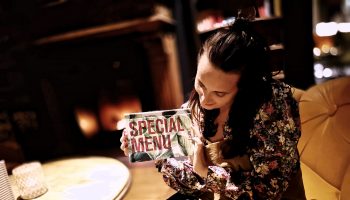My personal highlight: Learning 1:1 from a truffle connoisseur about how to recognize a quality white truffle!
The aim of my piedmont travel this year was all in the light of the International Alba White Truffle Fair – Fiera Internazionale del Tartufo Bianco d’Alba. It takes place from always beginning of October until the end of November and attracts people from all over the world. At the fair local truffle, sellers gather to have their Tartufo officially evaluated for quality before they are ready to be sold. Besides truffles, you can try and buy pasta (with and without truffles), olive oil, wines and delicious roasted hazelnuts. During the fair, there is the chance to attend a variety of workshops or tasting classes, too.
White Alba truffle can be found only from late September to January
What I found special at this fair is the chance to talk to the truffle hunters also called “trifulau” and get all the insights about this unique product. They are legendary characters who live in secrets and observation wandering around forests in search of truffles for resale at restaurants, markets, and fairs. To see with one’s eyes the relationship between man and dog is another added value.
What exactly is a truffle?
The term truffle comes from the vulgar Latin “tufera” which had in the Middle Ages negative resonances, even poisoned fruit, of plant tumour. Truffles are the fruiting body of mushrooms. They are born and live under the ground. For this reason, they are called hypogea and belong to the family of Tuberaceae, a class of Ascomiceti.
Truffles exist due to symbiosis with the roots of plants from which minerals and other nutrients are exchanged. This is why the type of plant affects the characteristics of truffles: for white, the main responsible plants are wild poplar, oak, lime and wild willow.
How to recognize if a truffle is of high quality?
With a sensorial analysis of touching, smelling and sight you understand its quality. The price of truffles increases when the aesthetic appearance is impeccable. Truffles with slight cuts or holes, maintaining a flavour can cost much less. An excessive amount of ammonia is a sign of a truffle to be discarded, as well as a bad consistency. That is why these evaluations are important and helpful to understand if the price you pay is good. At the fair, you can get every truffle you buy checked by an official jury.
Planning your Piedmont trip – including one of the most beautiful UNESCO World Heritage sites: the wine yards as Langhe, Monferrato and Roero and several foods stops along the way!
First stop on your route: Alba
Alba is a territory that offers an excellent food choice (the region counts as one of Italy’s highest concentrations of Michelin-starred restaurants) and some of the globe’s most beloved powerhouse wine regions such as Barolo, Barbaresco and Asti.
One of my personal highlights was the walk through Alba centre where I got seduced by the unmistakable smell of roasted hazelnuts coming from the company Ferrero
Another fun fact: the Slow Food movement was born in Piedmont. Here every year different culinary events such as the fair “cheese” take place where people from all over the world join to try and explore different delicacies.
This area is stamped with grand cathedrals, five-star hotels, and meandering cobblestone-lined streets. In the mood to know more about cultural sites to visit, check this site!
Visiting Asti!
In Asti I absolutely recommend seeing the Cathedral of Santa Maria Assunta, it is one of the most important Gothic cathedrals in Piedmont. Want to add a culinary experience to your cultural site visit? Buy one of the best handmade 100% hazelnut cakes at the shop: Daniella! This laboratory creates artisan biscuits, tarts and cakes that you won’t find anywhere else!
Rumor say, that Dagobert Duck used to live in one of the tower located in the medieval heart of Asti: the tower of the Palazzo Gazzelli di Rossana, in the city centre
Explore Barbaresco and the home of one of the most famous Italian wine producers called Gaia
My favourite village on the trip was the city of Barbaresco. This is the home of one of the most famous Italian wine producers called Gaia, a family business founded in 1859 when Giovanni Gaja turned his tavern into a winery. Thanks to this genius, Barbaresco was lifted from the shadows of neighbouring Barolo! Gaja produces four great Italian red wines as Barbaresco, Brunello di Montalcino, Bolgheri (the region of the Tuscany) and even Barolo.
Once in Barbaresco make sure to make it all the way up to the Barbaresco tower. The view from the 3d level is breathtaking. At the top, the view goes beyond the Tanaro river, situated roughly 200 meters below, towards the Langhe, the Roero, the Astigiano and Monferrato and as far as the Alpine mountain chain. This is where you get a complete picture of this area.
Driving through Piedmont you can admire landscapes of kiwi fields and hazelnuts trees!
Are you in the mood to experience some local food producers and taste homemade raw veal salsiccia in Bra?
In the city of Bra, you see mostly small, family-run shops. A must-try is the raw “Salsiccia di Bra”. The sausage is made of lean cattle meat mixed with belly pork (20-30%), water and a secret mix of spices. Buy it at the shop Macelleria Tibaldi Davide.
Put this on your list, too: the oldest pastry in town “Caffe Pasticceria Converso“. Since 1838 here 100% handmade pastry made of pure hazelnuts and other genuine local ingredients are created with pure passion.
How to find wineries for your Piedmont wine tour
In a previous blog story, I introduced the region of Langhe. Get all travel information on how to best organize your wine tour here!
A new wine producer I discovered during this year’s trip is the winery Coppo. Coppo is one of the oldest family-run wineries in all of Italy. The origins of the winery date back to 1892. The major part of the winery’s production centres on Barbera, Metodo Classico sparkling wines.
My absolute favourite white sparkling wine I found here: The Riserva Coppo sparkling wine brut metodo classico. Its perlage is very fine and the taste elegant and not too dry!
Where to eat on your Piedmont trip
- La libera, Alba – To recommend for dinner in the city centre of Alba. Exquisite dishes as Carne cruda battuta al coltello (raw meat), Vitello tonnato, Ravioli di gallina nel suo brodo or Agnolotti del Plin with truffle in an ambience that takes care about design.
- Ristorante Piazza Duomo, Alba – 3 Michelin Star absolutely worth making this experience and try Chef Enrico Crippa’s uninventive, artistic Italian dishes matched with superb wines from the region.
- Osteria dei Meravigliati , Canelli – A place to enjoy a traditional lunch with starters as Gobbo Di Nizza with a fontina cheese sauce and an egg (with or without truffle) and some homemade Tajarin pasta (typical local pasta) with truffle.
- Restaurant Campamac, Barbaresco – a 1 Michelin Star restaurant with one of the most beautiful wine cellars in Italy! Chef Maurilio Garola
- Il Cascinale Nuovo, Isola D’asti, 1 Michelin Star, Chef Walter Ferretto, find traditional and innovative cuisine using great Piedmontese ingredients with the scents and flavours from every corner of the world.
- Restaurant Fre – Monforte D’Alba, 1 Michelin Star, Chef Paolo Meneguz, a top-notch gastronomic experience that’s rooted in the region but holds an international, modern appeal.
Where to sleep on your Piedmont trip
-
-
-
- Villa D’Amelia, Benevello – 4 Stars, Rooms as of 255 Euro
- Relais & Chateau Castello Di Guarene (18th-century ) Guarene – 5 Stars, Rooms as of 350 Euro
- Relais & Chateau San Maurizio, Santo Stefano Belbo – 5 Stars, Rooms as of 290 Euro
- Arborina Relais, Boutique hotel, La Morra – perfectly integrated into the surrounding nature and landscape, a marvellous belvedere looking onto the rolling Barolo hills – Rooms as of 260 Euro
- Cà Vittoria Hotel & 1 Michelin Star Restaurant, Tigliole d’Asti – Rooms as of 160 Euro
- LA Madernassa Resort, Guareene – Rooms as of 100 Euro ca.
- Villa Tiboldi, Canale, 4 Star Hotel, Rooms as of 120 Eeuro
-
-
A warm thank you to the tourism office of Langhe Monferrato and Roero and especially to our guide Gaia that made this press trip very precious and memorable.
Get more Lovefoodish Travel Stories here!
Booking.com




















